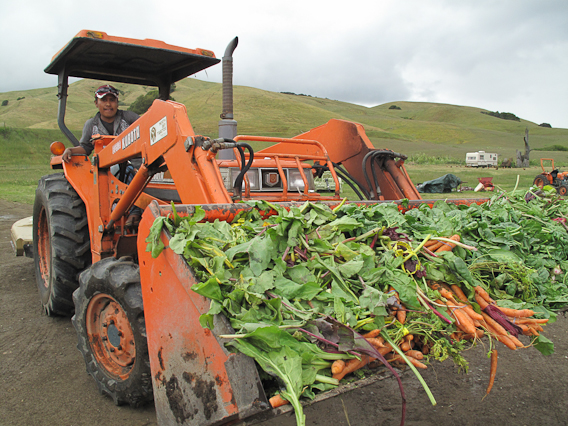 You notice the colors first. The crisp orange of carrots, the lustrous reds of tomatoes, the brilliant yellow of peppers and lemons, and everywhere, the thousand shades of green that seem almost to sing the word: fresh. Forklifts and hand trucks whir past crates of asparagus, long beans and onions; shouts ring out in English and Spanish and Chinese. It’s 2 AM, the air is nearly as cold as the walk-in coolers, and the San Francisco Wholesale Produce Market, all 25 acres of it, is alive with the sights and sounds of bustling commerce.
You notice the colors first. The crisp orange of carrots, the lustrous reds of tomatoes, the brilliant yellow of peppers and lemons, and everywhere, the thousand shades of green that seem almost to sing the word: fresh. Forklifts and hand trucks whir past crates of asparagus, long beans and onions; shouts ring out in English and Spanish and Chinese. It’s 2 AM, the air is nearly as cold as the walk-in coolers, and the San Francisco Wholesale Produce Market, all 25 acres of it, is alive with the sights and sounds of bustling commerce.
Wholesale produce markets like this are the missing link of the fresh, local food supply chain, providing the crucial connection between producers and the people who live near by. If you don’t have one near you–and you probably don’t–then chances are that you’re paying too much money for produce that was grown too far away.
A century ago, overnight wholesale produce markets dotted the country, a link between farmers and city dwellers that dates back to the time before refrigerators, when all fresh food was, by necessity, local. Since the 1950s, though, wholesale produce markets have been pushed out of city centers by urban redevelopment, and to the brink of irrelevance by ever-larger grocery chains with their own international-scale production and distribution systems.
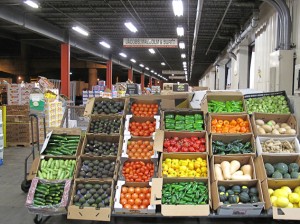
And that’s a problem: without reliable wholesale markets, producers can’t grow much beyond hobby-farm size, making local food an expensive specialty item. Local produce is often relegated to the artisanal confines of the farmers’ market as a result, while supermarkets bring food in from thousands of miles away.
There’s nothing wrong with farmers’ markets of course—if you don’t mind paying double for tomatoes that will go mushy in a day, because they were picked at peak ripeness and have been sitting in the back of a pickup truck since the day before. And having grown up in a place where fresh greens in winter still seem like a miracle, I’ve got nothing inherently against produce with some serious food miles on it. But if local, fresh food is going to work at any kind of scale, wholesale markets are the critical missing infrastructure.
The San Francisco Market was pushed from downtown to the remote Bayview neighborhood in 1963, to make way for tourists and office space. Some very lean years followed, and the market’s general manager, Michael Janis, recalls with a frown that the technical term for the wholesale hubs—“terminal markets” – took on an ominous meaning: the running joke was that the venerable institutions had one foot in the grave.
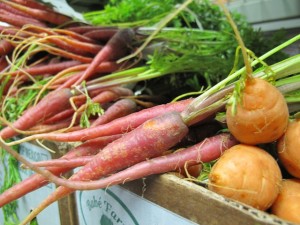 After decades of decline, wholesale produce markets in the US are finally being developed again. Philadelphia’s market opened a massive new facility in June, and the San Francisco market is set to start an $80 million project to modernize and expand by more than half. Of the 72 wholesale markets and other “food hubs” that the US Department of Agriculture identified in a recent study as key distributors of fresh food, 60 percent were established in just the last five years.
After decades of decline, wholesale produce markets in the US are finally being developed again. Philadelphia’s market opened a massive new facility in June, and the San Francisco market is set to start an $80 million project to modernize and expand by more than half. Of the 72 wholesale markets and other “food hubs” that the US Department of Agriculture identified in a recent study as key distributors of fresh food, 60 percent were established in just the last five years.
The San Francisco market’s 30-or-so independent wholesalers pull in fresh produce from across California (and beyond—there’s no strict rule on localness, just a tendency) and sell it to thousands of restaurants, corner markets, local grocery chains and caterers throughout the region. Incoming deliveries start in the evening, the market reaches its peak activity in the smallest hours of the night, and by the time most of us are making our way to work, the site is all but abandoned, its businesses shuttered for the day.
Even in this most food-obsessed of cities, most eaters don’t even know that the San Francisco market exists. I wouldn’t either, if I didn’t ride my bike past it on my way home from the train to the even more obscure area of the city where I live. The market is long-closed by the time I struggle past, but I got curious, and visited during its peak hours, in the middle of the night. Okay, I actually got a little obsessed, especially with a particularly awesome salad mix I found there. But more on that in a moment.
Andy Powning showed up at the market about 30 years before I did. He works at a locally focused wholesaler called GreenLeaf, and has done everything from deliveries and sales to growing exotic herbs and culinary flowers on his own half-acre farm. He remembers when the company’s main role was supplying cheap produce to the hippie communes that still flourished at the time.
Standing in a cold storage room at the market, Powning says that wholesalers helped nurture the transition to today’s food culture, in which Belgian endive and “spring mix” salad greens are commonplace rather than rarities. Holding a tiny, perfect bunch of 2-inch-long rainbow-hued baby carrots in his hands, he says, “Thirty years ago you had carrots. They were orange, and they were large, and they came in a bag. And now, there’s a cornucopia of colors and shapes, and they taste…good.”
Every wholesaler works a little differently. Some are generalists, carrying a little of everything. Others specialize in particular products—onions, say, or asparagus—or in ethnic produce for Latino or Asian customers. And some, including GreenLeaf and Earl’s Organic, focus squarely on local and organic fruits and vegetables. As classic middlemen, they take a cut of the profits. But they also take care of finding customers whenever a crop is ready. For produce that can go from fresh to compost in a matter of days, that can mean the difference between a profitable business and an expensive hobby for small farmers.
David Retsky is one of those growers. He owns the County Line Harvest farm near Petaluma, California; six charming acres nestled in a green valley in Marin County, just north of San Francisco. And he grows the best damn lettuce I’ve ever had. So naturally I wanted to go see how he does it.
When Retsky started growing organic lettuce, broccoli, carrots and other produce there a decade ago, he made his own deliveries. Today, he sells most of his produce through GreenLeaf. He and the company agree on a set price for each of his crops. That frees Retsky from the vagaries of a volatile market that can swing up and down by the day, depending on supply and demand.
It also frees Retsky to spend his time in the field, rather than behind the wheel of a delivery truck. “Our price is definitely a bit lower because we have a middleman,” he told me when I showed up on his farm earlier this summer. But he’s smiling as he pulls a sharp knife with a long, triangular blade from his back pocket, drops to his knees, and harvests a small head of red oak leaf lettuce with a single quick slice. “But I figured, let me farm and let them distribute.”
GreenLeaf sells more than 600 cases of Retsky’s lettuce through the San Francisco produce market every week—and at 24 heads a case, that’s a lot of salad. It goes from the market to hundreds of northern California restaurants, such as the popular, mellow Park Chow on the southern edge of Golden Gate Park in San Francisco. It was on the way home, so I stopped in. Adam Marchetti, Chow’s executive chef, says that the wholesale market makes it easy to build a menu around affordable local food, which is this local chain’s specialty. He buys several cases of Retsky’s lettuce every day.
You can see the pleasure in his eyes as Marchetti opens a case of County Line Harvest mixed baby lettuce in Park Chow’s kitchen. The small, perfect heads could have been in the ground just yesterday. Marchetti turns them into salad with knife work as sure and agile as Retsky’s. Although the two men have never met, they’re linked directly by the lettuce that one grows and the other serves, and by a market that is as overlooked as it is essential. And that’s the funny thing about infrastructure—it doesn’t really matter if no one notices it, so long as it’s there.
***
Photos by the author. Special thanks to Gisele Grayson, who cares about lettuce every bit as much as I do.
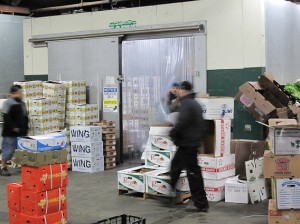
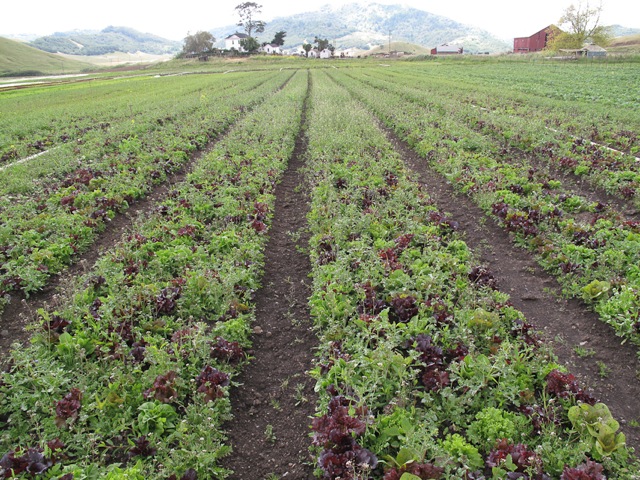
I agree with you there. Wholesale markets allow farmers to sell large bulks faster, lessening spoilage. Buyers on the other hand can be particular with the packaging requirements as well as accept only those that are already proven to be high quality produce. Downside however is that the price of organic produce may vary a lot from time to time since it is dependent on the current retail market price. There are several pros and cons to it but personally, I believe that the pros outweigh the cons in this current situation
Excellent article, thank you Thomas! Despite the enormous “public” popularity of farmers markets (especially in the Bay Area), the impact they have had on direct marketing distribution remains minimal. According to a recent report by the USDA, farmers markets nationally represent less than 0.5% of total agricultural sales, and the numbers are only slightly higher, still less than 1%, in the 9 county Bay Area. What are the opportunities for a wholesale distribution market like ours in SF to include a retail distribution component, so that individual shoppers could also access fresh produce at a larger scale, without the markups associated with the ‘artisanal confines’ of typical farmers markets. The nearby Alemany Market seems like a good model in terms of scale and accessibility, but they are still only open once a week (presumably the farmers’ ‘day off’). Wholesale and public markets for local food are an incredible asset for urban communities, but also provide a stable economic return for farmers, which could help keep farmland profitable and preserve it from low-density urban development, etc. Markets in many large cities around the world incorporate public retail components (the Tsukiji fish market in Tokyo or the incredible markets program in Barcelona). What’s stopping us in SF? Imagine the local development/public space/informal economic benefits of such a market….
Thanks Chris, You’re right–farmer’s markets can be great for farmers (who can charge top dollar for “2nd best” produce, i.e. stuff that is lumpy or misshapen, and is going to wilt the next day, because people tend to eat what they buy at farmer’s markets on the same day, and to have a higher tolerance for gnarly looking produce when they buy it out of a truck) and for consumers (who can get fresh, local, tasty produce and get a step closer to the land.) But it’s a tiny part of the food system, and very difficult to scale up a great deal more.
It’s a little known fact that some wholesalers at produce markets, including at the SF market, will actually sell to the general public–you don’t need to be a retailer the way you do at the SF Flower Mart, or restaurant supply wholesalers etc. They don’t advertise the fact though, because they aren’t really set up to handle walk-up purchases, and you can only by produce by the box or crate. But if you need 24 heads of lettuce, or five pounds of blueberries, and don’t mind getting up at 4 in the morning to get ’em, you’d be nuts to go anywhere else.
Thanks Thomas! This is an important part of the food system that I usually overlook when I think about promoting local and sustainable agriculture.
I’m interested if you see any new business models for wholesalers springing up in the Bay Area. Are specialty operations like GreenLeaf really “new” or did they just replcace other high-end wholesalers? Are any wholesalers doing CSA-style subscription services or other kinds of combined retail-wholesale operations?